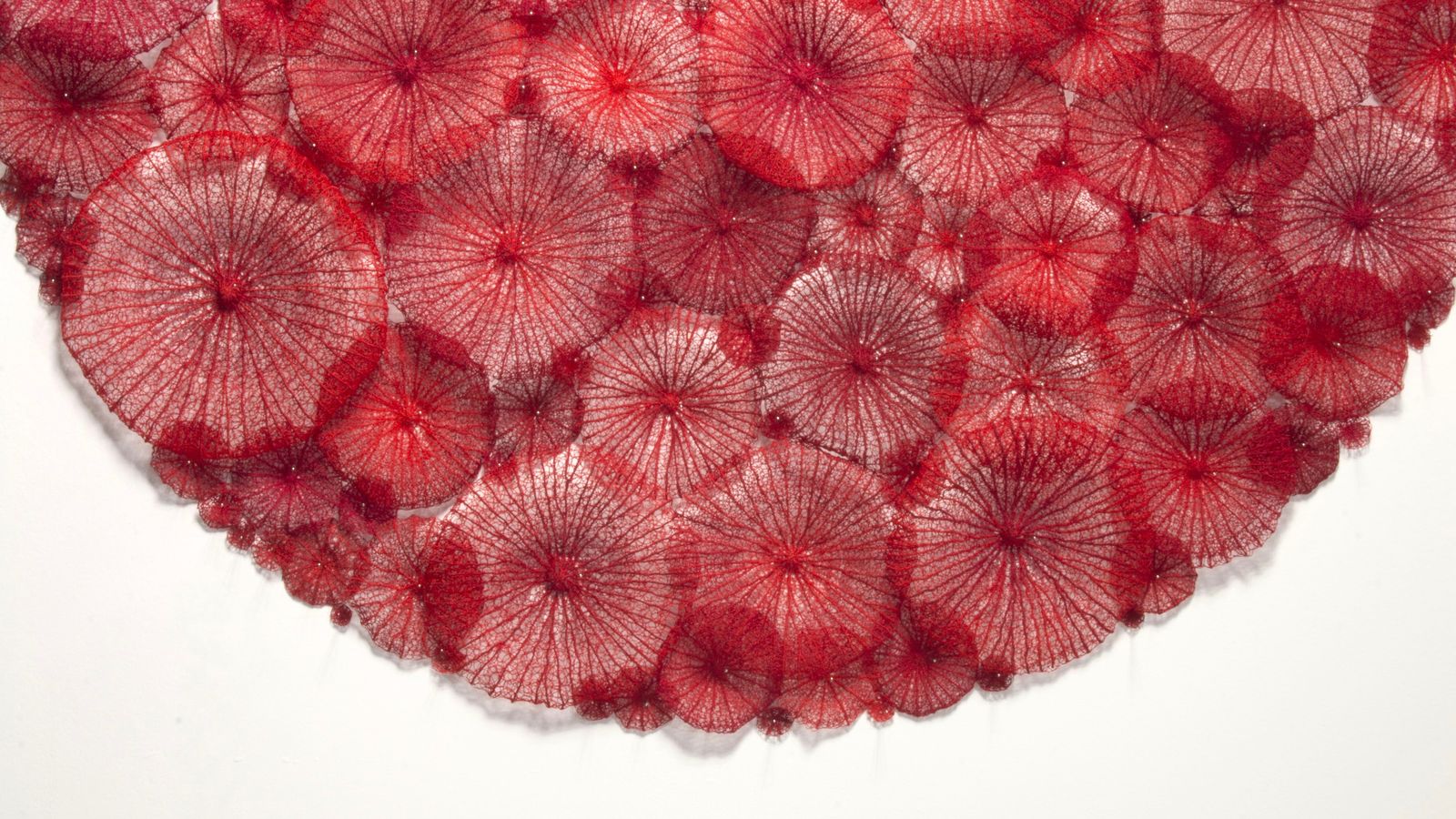Meredith Woolnough
The New Neighbours, 2017

Coral reefs are under stress due to rising sea temperatures. It has been predicted that 90 per cent of the world’s coral will be dead by 2050.
In the face of this devastating statistic, I can’t help but wonder what the world will be like without coral reefs. What will these beautiful, fascinating and important ecosystems look like after climate change has destroyed the majority of them? Will they become barren wastelands, or will the reefs evolve into a new kind of ecosystem, with new dominant species? While many species will perish under the impending harsh conditions, there will always be those that are able to adapt, survive and even thrive in the face of change.
The New Neighbours explores how the transformed reefs might appear after secondary colonisers have moved in. The embroidered forms that make up the installation are inspired by a red Discosoma species, from the order Corallimorpharia. Colonies of Corallimorphs have been known to rapidly cover empty spaces in a reef, like a living carpet over coral rubble. Species from this order are hardy, fast- growing organisms that are resistant to pollution, water acidity and temperature changes, making them potential survivors of the impending reef destruction.
Meredith Woolnough is an internationally acclaimed, award-winning artist from Newcastle, NSW. Her work is held in public, private and corporate collections worldwide. Meredith’s elegant embroidered traceries capture the delicate beauty of nature in knotted embroidery threads. Through a system of tiny stitches, she creates intricate and complex openwork compositions that are then carefully pinned in shadowboxes, just like preserved specimens. In mapping the frameworks of the various veining systems found in nature, Meredith’s work explores the balance, harmony and connectivity of life on Earth. Inspired by the patterns, structures and shapes found in plants, corals, cells and shells, her embroideries represent both the robust beauty and the elegant fragility of life.
Artist Q&A:
What is the background to your practice?
I developed my unique way of stitching while studying a BFA at University. During my honours year I focused my attention on a freehand embroidery technique using a water-soluble base fabric. This allowed me to essentially create freeform stitched drawings with a sewing machine. I quickly discovered that these embroideries could be shaped and sculpted into various forms. I fell in love with the process and have been exploring it now for almost 15 years.
What are some of the technical challenges of your embroidery work?
I need to ensure that my stitched drawings are all very well connected before I wash away my base fabric. If there are any gaps in the embroidery my stitched drawing will simply fall apart and I will just be left with a tangle of threads to show for all of my hard work.
There are also limitations to working with embroidery in such a sculptural way like this. The materials I am working with are inherently soft and flexible and I don’t like to use any stiffening agents on my sculptures. So there are limitations to how large I can go – but I am always trying to push those limits, and some of the pieces in ‘The New Neighbours’ certainly do that.
How do people respond to 'The New Neighbours'? It’s so pretty, do they reflect on its environmental considerations?
‘The New Neighbours’ seems to spark lots of questions from the audience. Most people seem to be initially drawn to the large scale and vibrant colour of the piece. They then wonder about what it is made from and how it was made. I have heard several people comment that it reminds them of coral before they have read my artist statement, so I imagine that it connects with people on that level as well. Whether or not they reflect on its environmental considerations, I’m not sure.
Does most of your work have a climate focus?
Many of my works have subtle environmental comments woven into them, but it is not always obvious. It is difficult to work with a subject like coral for example and not find myself reflecting upon the devastating situation our oceans and reefs are currently facing. So ‘The New neighbours’ has a clear climate change focus. However many of my other works are simply studies and celebrations of natures beautiful systems.
How have you been managing your practice during COVID-19? Has it had an impact conceptually or to your process?
I am managing as best I can. Like many artists my work has been impacted by COVID-19, but I have been resolute about sticking to my current projects. I am currently working on a series called ‘The 100 Embroideries Project’, which, like the name suggests, is a series of 100 new pieces that will form the bulk of my next solo exhibition in August. The series is varied and while I have been tempted to incorporate COVID-19 forms and themes into the series at times, I think that nasty little bug has gotten enough attention for now so I am steering well clear of it.
Image: The New Neighbours (detail), 2017 Embroidery thread, pins Photo: Courtesy of the Artist
